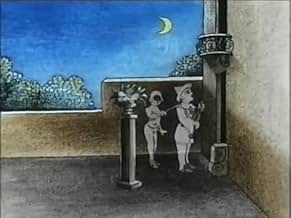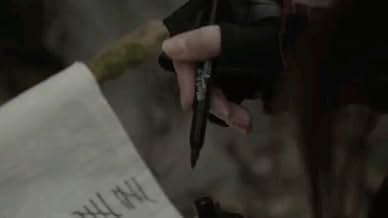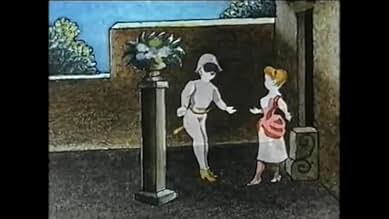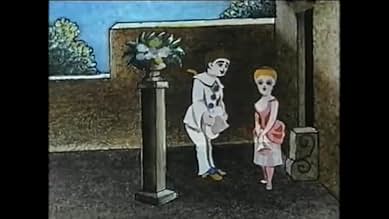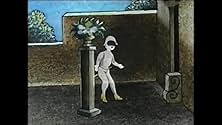IMDb-BEWERTUNG
6,5/10
2211
IHRE BEWERTUNG
Füge eine Handlung in deiner Sprache hinzuOne night, Arlequin come to see his lover Colombine. But then Pierrot knocks at the door and Colombine and Arlequin hide. Pierrot starts singing but Arlequin scares him and the poor man goes... Alles lesenOne night, Arlequin come to see his lover Colombine. But then Pierrot knocks at the door and Colombine and Arlequin hide. Pierrot starts singing but Arlequin scares him and the poor man goes away.One night, Arlequin come to see his lover Colombine. But then Pierrot knocks at the door and Colombine and Arlequin hide. Pierrot starts singing but Arlequin scares him and the poor man goes away.
- Regie
- Drehbuch
Empfohlene Bewertungen
Cute and strange; oh, and it's the first animated thing put to film... ever. Impressive for that alone, AND it has a story! It may not be too deep, and may be a little confusing (what's with the guy that comes out of nowhere and steals the guy's ukulele or whatever it is, is he a ghost?) But it does have a beginning, middle and sort of an end, maybe, arguably. For what this french animator was able to accomplish - and did I mention in COLOR no less - and for the simple fact that this is one of the major accomplishments of that century, to get something with images moving, albeit jerkily, I say you should check out all four minutes on YouTube or wherever silent film shorts are sold.
It's cheating a little to list this as a film as strictly speaking it's not one, though its maker Émile Reynaud pushed pre-cinema technology as far as it could go to achieve an experience practically indistinguishable from that of watching a theatrical presentation of an animated cartoon film. His Théâtre Optique featured his Praxinoscope, a radical development of old-established animation toys like the Zoetrope. This used rotating faceted mirrors and lenses that could project a succession of hand-drawn images from a paper strip with sprocket holes, allowing much longer sequences of continuous action than the short loops hitherto used in such devices. These images were then superimposed on a static background projected from a conventional magic lantern slide, prefiguring later cel animation techniques in which the image is broken down into a succession of layers with the minimum of movement in each one. The exhibition was completed with live narration and music.
Some of Reynaud's original elements survive (others he later threw in the Seine) and their affinity with film is demonstrated by the ease with which they can be reconstructed on modern film or video. Pauvre Pierrot was the first such production and is among the most charming, a simple tale featuring the traditional characters Pierrot, Arlequin and Colombine acting out their ancient love triangle. Some reconstructions replicate the translucent, slightly ghostly quality the characters would have had at the time. Sadly Reynaud's work was overtaken by the arrival of the cinema proper and he died a poor and unhappy man.
Some of Reynaud's original elements survive (others he later threw in the Seine) and their affinity with film is demonstrated by the ease with which they can be reconstructed on modern film or video. Pauvre Pierrot was the first such production and is among the most charming, a simple tale featuring the traditional characters Pierrot, Arlequin and Colombine acting out their ancient love triangle. Some reconstructions replicate the translucent, slightly ghostly quality the characters would have had at the time. Sadly Reynaud's work was overtaken by the arrival of the cinema proper and he died a poor and unhappy man.
It is said that Pauvre Pierrot (1892) was the first animated film ever (it was presented with Le Clown et ses chiens (1892) and Un bon bock (1892)). Was exhibited in October 1892 when Charles-Émile Reynaud opened his Théâtre Optique at the Musée Grévin. It is probably the first usage of film perforations. Pauvre Pierrot originally consisted of 500 individually painted images, which originally was 15 minutes long, but the 1996 restoration made it 4 minutes long.
The story is about Harlequin (best-known of the zanni or comic servant characters from the Italian Commedia dell'arte), Colombina (a stock character in the Commedia dell'Arte, she is Harlequin's mistress, a comic servant playing the tricky slave type and wife of Pierrot) and Pierrot (is a stock character of pantomime and Commedia dell'Arte). It is a comedy, though nowadays it isn't that funny, in its time it must have been one of the funniest things that existed. I wish I was there when it happened.
The story is about Harlequin (best-known of the zanni or comic servant characters from the Italian Commedia dell'arte), Colombina (a stock character in the Commedia dell'Arte, she is Harlequin's mistress, a comic servant playing the tricky slave type and wife of Pierrot) and Pierrot (is a stock character of pantomime and Commedia dell'Arte). It is a comedy, though nowadays it isn't that funny, in its time it must have been one of the funniest things that existed. I wish I was there when it happened.
This is a very, very, very, very impressive movie for 1892. Yes, 1892! Edison was still experimenting with his Kinetoscope in America, Etienne-Jules Marey was using his Chronophotographic Gun to shoot film experiments, and films were, like, 3 seconds! Charles-Emile Reynaud's "Pauve Pierrot" originally ran 15 minutes, is in painted color by Reynaud himself, and (drum-roll, please) is animated! 1892, and this is the first cartoon! It consists of 500 images, tells a story, and is something you'd think came much, much later than this!
That's not to say it doesn't have any flaws. It definitely does. For one thing, while this is animation, it is very, very primitive looking by today's standards. The figures' movements are jerky, and at times they don't move at all. One particularly poorly animated spot is when Colombine comes out to meet Harlequin, as well as when she opens the door for Pierrot. Also, while sometimes there is some cutting closer to the figures, we mostly view what's going on from a single vantage point. If you decide to see this, bear in mind that, while ground-breaking, the animation isn't anything like what you'd see nowadays.
It's so sad. So much of Reynaud's work is lost today. The only other available cartoon from him is "Autour d'un Cabine" from 1894. His other two cartoons, "Le Clown et ses Chiens" and "Un Bon Bock" were both thrown into the Seine by Reynaud himself. Luckily, he spared these two movies so they could be seen and appreciated today.
That's not to say it doesn't have any flaws. It definitely does. For one thing, while this is animation, it is very, very primitive looking by today's standards. The figures' movements are jerky, and at times they don't move at all. One particularly poorly animated spot is when Colombine comes out to meet Harlequin, as well as when she opens the door for Pierrot. Also, while sometimes there is some cutting closer to the figures, we mostly view what's going on from a single vantage point. If you decide to see this, bear in mind that, while ground-breaking, the animation isn't anything like what you'd see nowadays.
It's so sad. So much of Reynaud's work is lost today. The only other available cartoon from him is "Autour d'un Cabine" from 1894. His other two cartoons, "Le Clown et ses Chiens" and "Un Bon Bock" were both thrown into the Seine by Reynaud himself. Luckily, he spared these two movies so they could be seen and appreciated today.
Pauvre Pierrot (1892)
This French film is considered one of the first animated movies ever made. From original reports it seems that the movie lasted longer than what's available in its current version but even at just four-minutes you can't help but be somewhat amazed at what great quality the film actually is. The plot is quite simple and deals with two men and a woman that they both want.
I will just leave the story at that but the main reason to watch this is for the beautiful animation. Now, it should go without saying but this movie was made in 1892 so one really shouldn't be expecting the work of Walt Disney. The film has a very fresh look to it and I must say that the colorful background is certainly the highlight.
This French film is considered one of the first animated movies ever made. From original reports it seems that the movie lasted longer than what's available in its current version but even at just four-minutes you can't help but be somewhat amazed at what great quality the film actually is. The plot is quite simple and deals with two men and a woman that they both want.
I will just leave the story at that but the main reason to watch this is for the beautiful animation. Now, it should go without saying but this movie was made in 1892 so one really shouldn't be expecting the work of Walt Disney. The film has a very fresh look to it and I must say that the colorful background is certainly the highlight.
Wusstest du schon
- WissenswertesThe cartoon was hand drawn on hundreds of sheets of glass, each inlaid in a leather strips, through which a light was shone projecting the figures on a backdrop, as it was spooled from one reel to another, much like a modern film reel.
- VerbindungenFeatured in La magie Méliès (2002)
Top-Auswahl
Melde dich zum Bewerten an und greife auf die Watchlist für personalisierte Empfehlungen zu.
Details
- Erscheinungsdatum
- Herkunftsland
- Sprache
- Auch bekannt als
- Armer Pierrot
- Weitere beteiligte Unternehmen bei IMDbPro anzeigen
- Laufzeit5 Minuten
- Sound-Mix
Zu dieser Seite beitragen
Bearbeitung vorschlagen oder fehlenden Inhalt hinzufügen

Oberste Lücke
By what name was Pauvre Pierrot (1892) officially released in Canada in English?
Antwort
